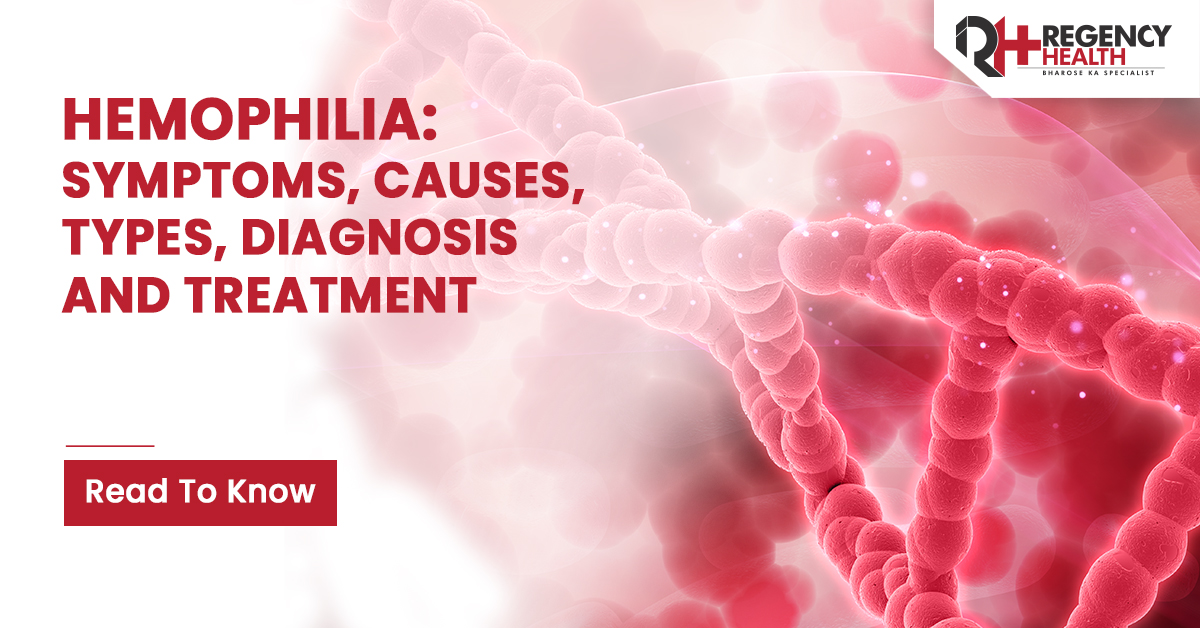
What is Hemophilia?
Hemophilia is a condition where a person’s blood doesn’t clot normally, which can cause excessive and uncontrollable bleeding. Our blood contains a clotting factor which is a protein that aids in stopping the flow. People suffering from Hemophilia have a lower level of clotting factor which can increase the risk of excessive bleeding.
Hemophilia is a hereditary condition that typically affects middle-aged or older individuals along with women who have either recently given birth or are in their final stages of pregnancy.
Types of Hemophilia
Hemophilia A – It is the most common form that is brought on by a deficiency in clotting factor 8. Although it is a hereditary condition that is passed down from parents to children, only one-third of cases occur due to a spontaneous gene mutation.
Hemophilia B– In this type, clotting factor 9 is inadequate in the patients. It is a hereditary disorder, similar to hemophilia A, and around one-third of cases are brought on by a spontaneous mutation. Internal bleeding can happen in joints and muscles, while external bleeding might result from small incisions, dental work, or trauma.
Hemophilia C– Lack of clotting factor 11 is the main feature of hemophilia C. In contrast to categories A and B, bleeding happens only when there is an existing joint issue. An individual with hemophilia C is more prone to experience prolonged bleeding following surgery, dental work, or trauma. Hemophilia C has an equal impact on men and women.
Causes of Hemophilia
Clotting factors are made by certain genes. The genes that convey the instructions for producing healthy clotting factors mutate or alter in inherited hemophilia. The defective genes may lead to the production of insufficient or incorrect clotting factors. However, 20% of all cases of hemophilia are considered to be spontaneous, indicating that the person does not have a family history of unusual bleeding.
Symptoms of Hemophilia
Unusual or profuse bleeding and bruising is the main symptom of Hemophilia. After small injuries, people with hemophilia may see noticeable bruises. This indicates that they are bleeding under the skin.
- Whether it’s bleeding after surgery, bleeding after dental work, or just bleeding from a cut finger, they may bleed for an exceptionally long time.
- They can begin bleeding for no apparent reason, like an unexpected nosebleed.
- Joint pains as a result of internal bleeding
- Headaches, and blurred vision due to brain bleeding
Diagnosis of Hemophilia
Diagnosis for Hemophilia can be done by performing a thorough medical history check and physical exam. Visit your nearest multi super speciality hospital to get checked if you display any of the symptoms. The medical professional will inquire about your family’s medical history if you exhibit hemophilia symptoms. The following tests are done to confirm the condition.
Complete Blood Count (CBC) – This test counts the number of white blood cells, platelets, and red blood cells in the blood as well as the amount of hemoglobin. Apart from this the hematocrit (the percentage of blood volume occupied by red blood cells), the size and number of red blood cells are also found through this test.
Prothrombin Time – Indicates time taken for the blood to clot.
Clotting Factor Tests– The kind of hemophilia and its severity are identified by clotting factor testing, which is necessary for the diagnosis of a bleeding disorder. They determine whether you have mild, moderate, or severe hemophilia by looking at the amounts of factor 8 or factor 9 in your blood.
Treatment for Hemophilia
Hemophilia treatment is primarily aimed at increasing clotting factor levels or administering replacement treatment (which replaces missing clotting factors).
In replacement therapy, you get lab-made (recombinant) clotting factors or human plasma concentrates. Typically, only those with severe hemophilia require regular replacement therapy. Replacement therapy may be given to those with mild or severe hemophilia in need of surgery. Additionally, patients might be given antifibrinolytics, a drug that prevents blood clots from dissolving.
Blood factor concentrates are created from donated human blood that has undergone screening and treatment to lower the risk of hepatitis and HIV transmission. Replacement factors are administered to patients by intravenous infusion. Infusions of prophylactic factor may be recommended by your doctor if you have severe hemophilia and frequently experience bleeding episodes.

 Call-an-Ambulance
Call-an-Ambulance



